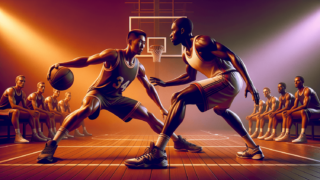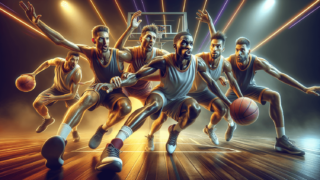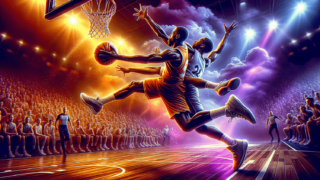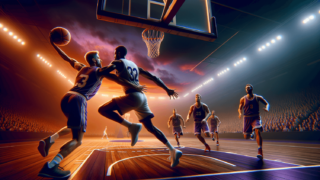
Disqualification Rule in Basketball: How It Works
Written by: Basketball Universe
Last updated:

Welcome to the intriguing world of basketball rules! Today, we will dive into the fascinating topic of the disqualification rule, a pivotal part of the game that can truly make or break a team’s strategy and performance. A rule often misunderstood yet vital in maintaining fair play and sportsmanship on the court. Get ready to have your hoop knowledge expanded as we tackle the ins and outs of the disqualification rule and how it affects the game we all love.
Disqualification Rule in Basketball: How It Works
In basketball, the disqualification rule comes into effect when a player accumulates a specific number of personal fouls or a combination of technical fouls and personal fouls during a single game. In the NBA and NCAA, this limit is six personal fouls or two technical fouls. Once a player reaches this limit, they are disqualified from the game and must be substituted. The rule aims to maintain fair play and ensure that teams play within the spirit of the game.
Understanding Fouls in Basketball
Before we delve deeper into the disqualification rule, it’s essential to have a solid understanding of fouls in basketball. Fouls play a significant role in determining when a player gets disqualified, so let’s break them down into two categories: personal fouls and technical fouls.
Personal Fouls
Personal fouls are the most common fouls in basketball and involve illegal contact between players. They occur when the defensive player makes illegal contact with the offensive player, often limiting the offensive player’s movement, or when the offensive player initiates contact to gain an unfair advantage. Some common examples of personal fouls include:
- Blocking
- Charging
- Holding
- Pushing
- Hand-checking
Technical Fouls
Technical fouls, on the other hand, typically involve unsportsmanlike or inappropriate behavior and disrupt the smooth flow of the game. These fouls can be called on players, coaches, and even team personnel. Some common reasons for technical fouls include:
- Arguing with referees
- Demonstrative gestures or excessive celebrations
- Using abusive or profane language
- Intentionally delaying the game
Now that we have a better understanding of the two main types of fouls, let’s explore the disqualification rule in more detail.
How the Disqualification Rule Works
The disqualification rule in basketball prevents players from staying on the court when they’ve committed a certain number of fouls. This safeguards the integrity of the game and ensures teams don’t rely on overly aggressive tactics. While the exact numbers can vary across different leagues and levels of play, the general idea remains the same.
NBA and NCAA
In both the National Basketball Association (NBA) and the National Collegiate Athletic Association (NCAA), the disqualification rule applies when a player accumulates one of the following:
- Six personal fouls
- Two technical fouls
- A single flagrant foul and a technical foul
- Two flagrant fouls (automatic ejection)
FIBA and International Play
Under the International Basketball Federation (FIBA) rules, which govern international play and most leagues outside the United States, the disqualification rule is slightly different:
- Five personal fouls
- Two technical fouls
- A single unsportsmanlike foul and a technical foul
- Two unsportsmanlike fouls (automatic ejection)
- One disqualifying foul (automatic ejection)
High School Basketball
In most high school basketball games within the United States, players are disqualified when they accumulate five personal fouls. The technical foul rules vary from state to state, so it’s essential to familiarize yourself with local regulations.
Consequences of Disqualification
When a player is disqualified from the game, the effects can be felt on multiple levels – from individual player penalties to team ramifications.
Free Throws and Possession
One immediate consequence of reaching the foul limit is that the opposing team may be awarded free throws. In some cases, disqualifying fouls like technical fouls, unsportsmanlike fouls, or flagrant fouls will also result in the opposing team retaining possession of the ball.
Bench Depth and Fatigue
When key players get disqualified due to excessive fouling, a team’s bench depth becomes a major factor. Teams with limited options may struggle to cope without their top players, while fatigue could also set in as substitutes play more minutes than they’re used to.
Offensive and Defensive Strategy
A disqualified player can also disrupt a team’s offensive and defensive plans. Coaches might have to adjust their strategies on the fly to compensate for the absence of a key contributor, forcing teams to adapt to new styles of play or personnel groupings.
Managing Foul Trouble
To maintain a winning edge, teams must learn how to manage foul trouble effectively, as even star players aren’t immune to disqualifications. Basketball rules require coaches and players to think strategically, keeping an eye on individual foul counts and minimizing risks as much as possible.
Rotations and Substitutions
One of the most straightforward ways to manage foul trouble is through rotations and substitutions. Coaches must be aware of each player’s foul count and make decisions accordingly. In some cases, it may be wise to rest a key player for a few minutes to avoid reaching the disqualification limit too soon.
Adjusting Defenses
Teams can also manage foul trouble by adjusting their defensive schemes. For example, a player with four fouls might be switched to guard a less aggressive or offensively skilled opponent to minimize the chances of picking up another foul.
Exploiting the Rules
While basketball rules are in place to maintain a level playing field, clever tactics can sometimes be employed to exploit certain aspects of the game. Smart offensive players may attempt to create contact against a defender who’s already in foul trouble, forcing the referee to make a decision and potentially putting the defender one step closer to disqualification.
Disqualification Rule: When Stars See Red
Disqualification doesn’t discriminate, even amongst the best in the game. Here are some notable instances when star players have been disqualified, changing the course of a game or playoff series.
LeBron James (2012 Eastern Conference Finals)
In game 4 of the 2012 Eastern Conference Finals, LeBron James fouled out in overtime while playing for the Miami Heat. Despite LeBron’s absence, the Heat eked out a win against the Boston Celtics – a pivotal moment in their championship run.
Shaquille O’Neal (2000 NBA Finals)
Shaquille O’Neal, an NBA Hall of Famer, fouled out during the 2000 NBA Finals with the Los Angeles Lakers. In game 2, Shaq was disqualified after picking up his sixth personal foul in overtime. Nevertheless, the Lakers triumphed over the Indiana Pacers, thanks to a game-winning shot by Kobe Bryant.
Conclusion
The disqualification rule in basketball is a crucial aspect of the game, impacting individual and team performance in meaningful ways. As we’ve seen, even the finest players can find themselves sidelined by the rule, forcing teams to adapt and strategize around foul trouble. Understanding the intricacies of fouls and disqualifications can provide valuable insight into basketball rules and the game’s overall dynamics. So, next time you’re watching a game or lacing up your shoes for a pickup match, keep these insights in mind and enjoy the art of basketball!
Managing Player Reactions to Disqualification
Disqualifications can evoke strong emotions in players, coaches, and even fans. Understanding how to manage these reactions is essential for maintaining a positive atmosphere and ensuring that the game proceeds smoothly. Here are some tips for managing the psychological impact of disqualifications:
For Coaches
- Stay calm and communicate effectively with your players.
- Encourage your team to stay focused on the game, despite a significant player’s disqualification.
- Show support for the disqualified player and reassure them that they still have a role to play, whether it’s through morale support on the bench or learning from this experience.
- Use the disqualification as an opportunity for other players to step up and contribute to the team’s efforts.
For Players
- Accept the referee’s decision, even if you disagree.
- Remain engaged with the game from the bench – you can still show support and encouragement to your teammates.
- Focus on what you can learn from the situation and use it as motivation for future games.
- Be gracious in defeat, while also giving credit to your opponents if they’ve capitalized on your disqualification.
Disqualification Rule in Popular Culture
In the world of sports, movies, and television, depictions of dramatic disqualifications can create memorable moments that stay with us even years after they took place. From Hollywood films to TV episodes, here are some examples of how the disqualification rule has permeated popular culture:
Coach Carter (2005)
This inspiring movie, based on a true story, shows how high school basketball coach Ken Carter suspends his undefeated team when they break academic contracts. The film offers a unique perspective on the impact and consequences of disqualification, emphasizing the importance of academics and personal growth in the lives of young athletes.
The Fresh Prince of Bel-Air (Episode: “Courting Disaster”, 1993)
In a classic episode of the sitcom “The Fresh Prince of Bel-Air,” Will Smith’s character finds himself in foul trouble during an important game. As he approaches his foul limit, the tension rises, leading to comedic yet insightful moments that underline the significance of the disqualification rule in basketball.
FAQs About Disqualification Rule in Basketball
To aid your understanding, we’ve compiled a list of frequently asked questions related to the disqualification rule in basketball.
Can a disqualified player return to the game?
No, once a player has been disqualified due to fouls, they cannot return to the game. The disqualified player must be replaced by a substitute.
Can a basketball game end in disqualification?
A basketball game cannot technically end in disqualification, as there is no specific rule that allows it. However, if a team accumulates excessive fouls, they may find themselves at a significant disadvantage due to free throws and loss of players, potentially resulting in a loss.
Can a coach be disqualified?
Yes, a coach can be disqualified from a game due to excessive technical fouls or other unsportsmanlike actions. If the head coach receives any combination of two technical fouls, unsportsmanlike fouls, or disqualifying fouls, they will be ejected from the game.
Can a player be disqualified from future games?
In extreme cases, leagues and governing bodies may impose suspensions or bans on players who commit particularly egregious fouls or engage in other unsportsmanlike behavior. These suspensions can involve the disqualification of a player from future games, either temporarily or permanently.
FAQs Related to the Disqualification Rule in Basketball
Following our in-depth exploration of the disqualification rule in basketball, we’ve compiled a comprehensive FAQ section to address any remaining questions you might have about the rule and its impact on the game. Let’s dive in!
1. What is the main purpose of the disqualification rule in basketball?
The disqualification rule is in place to encourage fair play, maintain sportsmanship, and prevent overly aggressive tactics by removing players who commit too many fouls from the game.
2. How many personal fouls are required for disqualification in the NBA and NCAA?
In both the NBA and NCAA, a player is disqualified after accumulating six personal fouls.
3. What is the difference between a technical foul and a personal foul?
A personal foul involves illegal physical contact between players, while a technical foul typically results from unsportsmanlike conduct or other non-contact violations that disrupt the flow of the game.
4. Is the disqualification rule the same in every basketball league?
No, the disqualification rule can vary among different leagues and levels of play. It is crucial to familiarize yourself with the specific rules and regulations for the league you participate in or follow.
5. Can disqualified players re-enter the game?
No, once a player is disqualified due to fouls, they cannot return to the game and must be replaced by a substitute.
6. How does a disqualified player impact a team’s strategy during a game?
When a key player is disqualified, it can disrupt the team’s offensive and defensive strategies, resulting in possible adjustments to accommodate the absence of the disqualified player and increased reliance on bench players.
7. Can coaches also be disqualified or ejected from a game?
Yes, coaches can be disqualified or ejected from a game due to excessive technical fouls or other unsportsmanlike conduct on their part.
8. How do different leagues handle disqualifications for unsportsmanlike conduct?
Leagues may impose varying suspensions, fines, or penalties for players or coaches engaging in unsportsmanlike conduct, depending on the severity and frequency of the violations. It is essential to be aware of each league’s specific rules and potential consequences.
9. What are some examples of high-profile disqualifications in basketball history?
Examples include LeBron James’ disqualification during the 2012 Eastern Conference Finals and Shaquille O’Neal fouling out of game 2 during the 2000 NBA Finals.
10. How can players and teams minimize the risk of disqualifications?
Teams can reduce the risk of disqualification by managing their players’ foul counts, adjusting their defensive strategies, making strategic player substitutions, and remaining aware of their opponents’ foul-trouble situations to exploit any weaknesses they may present.
Featured Posts
- No pillar pages found.





